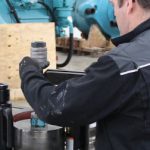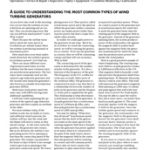The national unemployment rate is currently at 8.3 percent. The unemployment rate has been at or above 8.8 percent for the past 28 months. The underemployment rate has remained between 15.7 and 17.4 percent since the spring of 2009, and it currently stands at 16.1 percent. Additionally, the current skilled workforce is losing its qualified and experienced workers. On average 10,000 senior, experienced, knowledgeable, qualified workers will turn 65 years of age every day for the next 20 years, and as the 73 million folks leave the marketplace so goes their skills, talents, knowledge, and inherent trade techniques. With these kinds of numbers who would ever have thought that there was a very large unmet demand for skilled labor, or that the need for skilled labor would be in a niche marker sector like wind energy?
Since the end of World War II there has been an appreciating decline in skilled workers. This decline has grown immensely as the American economic engine has revved up. The Baby Boomers numbering in the ballpark of 73 million folks were the largest contributor to the skilled labor pool, but not large enough to meet the demands in the industry. The following generations of “X” and emerging generation of “Y” have not met the demand of the industry to date.
The Baby Boomers
By definition, a Baby Boomer is someone who was born between the years 1946 and 1964. As of right now Boomers are between the ages of 44 and 62. The Boomer generations are the folks who built and motivated the American economy for the last 60 years. Their social, cultural, and economic impact on the United States has been unprecedented in its history and is currently the single largest economic group in the United States today. The Boomers’ “work hard, play hard” mentality allowed them to have one of the highest discretionary income levels than any other age group, and it accounts for 45 percent of all consumer demand. As these Boomers retire and leave the workforce, the demands that they place on the goods and services producers and service providers will create some challenges as there are fewer folks to produce and service the retiring boomer society.
However, the Boomers have not saved very effectively for retirement, and some may be retiring early or moving into a less demanding working pattern, working less rigid jobs, playing golf on weekends, and dining at leisure all while still possessing their skills, talents, knowledge, and inherent trade techniques from a lifetime of hard work and no one to pass these skillsets on to. The exit of the Baby Boomer generation compounds an already looming crisis with the lack of qualified and skilled workers that has existed over the last 30 years. Skill levels in the U.S. workforce have stagnated, with Americans 25-34 years of age who do not possess the higher skills that their Baby Boomer parents do.
Generation X
The 46 million “X Generation” of sons and daughters of the Boomers did not wholly move into the skilled trade sectors, but instead went to college, sought professional degrees, jobs, and technical assignments, overall making much less income than their Boomer parents. They are officially the first generation to challenge the notion that that each generation will be better off than the one that preceded it. The study “Economic Mobility: Is the American Dream Alive and Well?” focuses on the income of males 30-39 in 2004 (those born April, 1964 – March, 1974) and is based on Census/BLS CPS March supplement data. The study, which was released on May 25, 2007, emphasized that in real dollars this generation’s men made less (by 12 percent) than their fathers had at that same age in 1974, thus reversing a historical trend. The study also suggests that per-year increases in the portion of father/son family household income generated by fathers/sons have slowed (from an average of 0.9 to 0.3 percent), barely keeping pace with inflation, though increases in overall father/son family household income are progressively higher each year because more women are entering the workplace, contributing to family household income.
In the next five years the X generation will make up the largest majority of the workforce in America, replacing the roughly 20 million skilled Boomers with only a third of the skilled workforce required to support the demands for goods and services. The balance of the X generation will continue to work in the professional services sector.
Generation Y
The roughly 80 million “Y Generation” folks entering the workforce today are the most technologically diverse generation in American history, but they barely make the global top 10 of educated and trainable workers. America is no longer a skill-abundant country compared with an increasing share of the rest of the world. As a result, in the coming decade America will face broad and substantial skill shortages.
The Y generation prefers to work independently with self-directed projects, responding to learning that provides interaction with their colleagues. They prefer more structure, direction, and social interaction. This generation is polite, believes in manners, adheres to strict moral code, and believes in civic action, but it also places a high value on making money—more than any other previous generation—and they see education as a means to this goal. Like the X generation before them, they seek professional careers. Studies predict that Generation Y will switch jobs frequently and will not have the passion for “the company” that older and more career established employees do. With the global booming numbers of Y generational workers added to the employment pool, economic prospects for the Y generation look bleak due to the late 2000 recession and a youth unemployment rate in the U.S. reaching a record level of close to 20 percent at the end of 2010.
As the Boomers exit, the X generation tries to fill the gap while the Y generation is looking to find a professional work environment. The question arises; Who is going physically move this country forward in the next 10-20 years?
Renewables and Labor
The resurgence of renewable energy installations possesses the potential to be a very large source of job creation. This virtually renewed industry demands highly skilled electrical and mechanical construction workers, heavy machinery operators, and professionals with a wide range of skills from chemistry, engineering, and physics to design, build, install, and maintain the infrastructure at these sites.
Since “skilled and qualified” workers of renewable infrastructure did not exist in any great numbers, the labor was pulled from the general skilled trades and the declining energy sectors to construct and maintain these sites. Because wind farms require permanent employees to maintain and operate them, wind energy produces jobs at different levels, in operation as well as in wind turbine component manufacturing and construction. These jobs, unlike other high-paying jobs in technology-based industries, are widely available in rural areas where wind farms are located.
These new jobs will require the personnel to interact with the equipment, either as a direct employee or a contractor and the ever-increasing regulatory component of the U.S. government is placing critical demands for protecting workers in the renewable energy sector, hence the ability to learn, adapt, and understand jobsite hazards is a must.
Human Resources
Unskilled native-born Americans do tend to compete with unskilled workers in the jobs marketplace, but the skilled workforce is still a challenge that has yet to be met for the growing immigrant labor pool.
The Y generation moving into the workforce may not be as motivated to take skilled labor, or “hands-on” jobs, due to their ability to easily seek education beyond high school and pursue professional careers where their income levels will be same as their X generation counterparts. It remains to be seen where this generation will end up, but whatever the outcome working long distances from home in remote isolated areas with limited communications and long workdays far away from social circles may create a challenge in retaining these folks. Since much of these renewable resources are constructed and installed in very rural areas many workers are leaving the ranch and farm to work in the industry. Many are pursuing educational opportunities from community colleges and universities that are developing renewable energy programs that offer a general education in wind, solar, and biomass engineering and maintenance technologies.
As with any resource, skilled labor will be in higher demand, which in turn will drive wages higher and demands for repairs, testing, and power generation equipment maintenance will push the skilled worker from employment with the renewable sites directly to contractors and suppliers. As these wages increase, so will labor rates for the services offered by electrical installers and repairmen. Eventually the annual incomes of skilled workers will match or outpace those of the professional worker.
If we want to build a skilled workforce in sufficient numbers to fill the jobs in the growing renewable energy industries, we will have to start before college. Students in high school who are beginning to consider career choices need to know that there are career opportunities in renewable energy. They also need to understand what workers in the renewable industries actually do on a daily basis to get a realistic idea of whether or not a job in renewable energy is right for them. That could be accomplished through internships for high school students as well as “job shadowing” opportunities during which students spend time with workers on the job, witnessing firsthand the skills and responsibilities those jobs require. To complete the process of ensuring that renewable energy firms have an adequate pool of skilled labor, we must build a strong “skill pipeline” from high school into college and to the workplace to provide an adequate number of skilled applicants for every type of position.
As the renewable market grows, opportunity will grow with it. This opportunity will be rich, with high-paying jobs that will have to compete for the qualified and skilled workers that choose to stay on their tools. Though the possibilities are endless for the Y generation to move into the skilled trades, it does not appear with the current trending to be the case anytime soon. The answer in the short term to who will fill the skilled trades’ gap may lie with international workers who possess similar skills, training and qualifications very similar to that of the native-born American counterparts.
Whatever the generational case may be, there are unfilled skilled jobs available in the renewable energy market sector, as well as those service providers who install, maintain, and repair the unique equipment that generates power from the wind and the sun—but you must be qualified to answer the call.






































